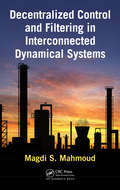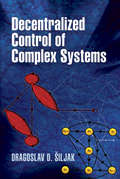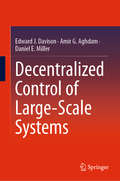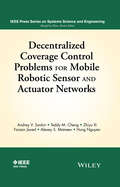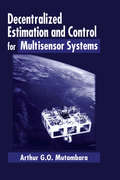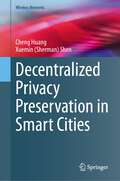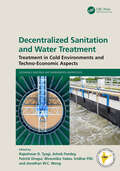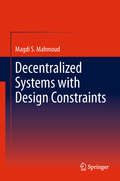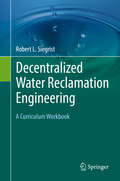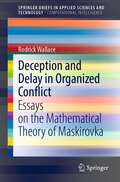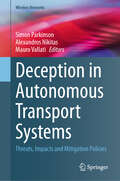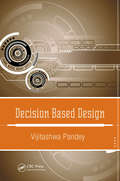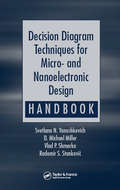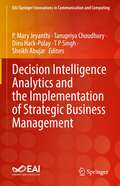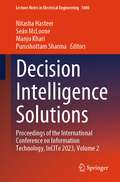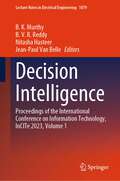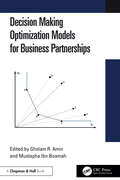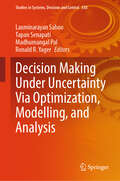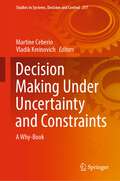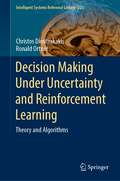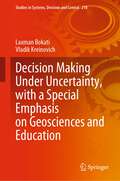- Table View
- List View
Decentralized Control and Filtering in Interconnected Dynamical Systems
by Magdi S. MahmoudBased on the many approaches available for dealing with large-scale systems (LSS), Decentralized Control and Filtering in Interconnected Dynamical Systems supplies a rigorous framework for studying the analysis, stability, and control problems of LSS. Providing an overall assessment of LSS theories, it addresses model order reduction, parametric un
Decentralized Control of Complex Systems (Dover Books on Electrical Engineering #Volume 184)
by Dragoslav D. SiljakStarting with a graph-theoretic framework for structural modeling of complex systems, this text presents results related to robust stabilization via decentralized state feedback. Subsequent chapters explore optimization, output feedback, the manipulative power of graphs, overlapping decompositions and the underlying inclusion principle, and reliability design. An appendix provides efficient graph algorithms. 1991 edition.
Decentralized Control of Large-Scale Systems
by Edward J. Davison Amir G. Aghdam Daniel E. MillerA large-scale system is composed of several interconnected subsystems. For such a system it is often desired to have some form of decentralization in the control structure, since it is typically not realistic to assume that all output measurements can be transmitted to every local control station. Problems of this kind can appear in electric power systems, communication networks, large space structures, robotic systems, economic systems, and traffic networks, to name only a few. Typical large-scale control systems have several local control stations which observe only local outputs and control only local inputs. All controllers are involved, however, in the control operation of the overall system. The focus of this book is on the efficient control of interconnected systems, and it presents systems analysis and controller synthesis techniques using a variety of methods. A systematic study of multi-input, multi-output systems is carried out and illustrative examples are given to clarify the ideas.
Decentralized Coverage Control Problems For Mobile Robotic Sensor and Actuator Networks
by Teddy M. Cheng Zhiyu Xi Alexey S. Matveev Faizan Javed Hung Nguyen Andrey V. SavkinThis book introduces various coverage control problems for mobile sensor networks including barrier, sweep and blanket. Unlike many existing algorithms, all of the robotic sensor and actuator motion algorithms developed in the book are fully decentralized or distributed, computationally efficient, easily implementable in engineering practice and based only on information on the closest neighbours of each mobile sensor and actuator and local information about the environment. Moreover, the mobile robotic sensors have no prior information about the environment in which they operation. These various types of coverage problems have never been covered before by a single book in a systematic way.Another topic of this book is the study of mobile robotic sensor and actuator networks. Many modern engineering applications include the use of sensor and actuator networks to provide efficient and effective monitoring and control of industrial and environmental processes. Such mobile sensor and actuator networks are able to achieve improved performance and efficient monitoring together with reduction in power consumption and production cost.
Decentralized Estimation and Control for Multisensor Systems
by Arthur G.O. MutambaraDecentralized Estimation and Control for Multisensor Systems explores the problem of developing scalable, decentralized estimation and control algorithms for linear and nonlinear multisensor systems. Such algorithms have extensive applications in modular robotics and complex or large scale systems, including the Mars Rover, the Mir station, and Space Shuttle Columbia.Most existing algorithms use some form of hierarchical or centralized structure for data gathering and processing. In contrast, in a fully decentralized system, all information is processed locally. A decentralized data fusion system includes a network of sensor nodes - each with its own processing facility, which together do not require any central processing or central communication facility. Only node-to-node communication and local system knowledge are permitted.Algorithms for decentralized data fusion systems based on the linear information filter have been developed, obtaining decentrally the same results as those in a conventional centralized data fusion system. However, these algorithms are limited, indicating that existing decentralized data fusion algorithms have limited scalability and are wasteful of communications and computation resources.Decentralized Estimation and Control forMultisensor Systems aims to remove current limitations in decentralized data fusion algorithms and to extend the decentralized principle to problems involving local control and actuation.The text discusses: Generalizing the linear Information filter to the problem of estimation for nonlinear systems Developing a decentralized form of the algorithm Solving the problem of fully connected topologies by using generalized model distribution where the nodal system involves only locally relevant states Reducing computational requirements by using smaller local model sizes Defining internodal communication Developing estima
Decentralized Privacy Preservation in Smart Cities (Wireless Networks)
by Xuemin (Sherman) Shen Cheng HuangThis book investigates decentralized trust-based privacy-preserving solutions in smart cities. The authors first present an overview of smart cities and privacy challenges and discuss the benefits of adopting decentralized trust models in achieving privacy preservation. The authors then give a comprehensive review of fundamental decentralized techniques and privacy-preserving cryptographic techniques. The next four chapters each detail a decentralized trust-based scheme, focusing respectively on privacy-preserving identity management, cross-domain authentication, data analytics, and data search, in specific use cases. Finally, the book explores open issues and outlines future research directions in the field of decentralized privacy preservation.
Decentralized Sanitation and Water Treatment: Treatment in Cold Environments and Techno-Economic Aspects (Sustainable Industrial and Environmental Bioprocesses)
by Ashok Pandey Rajeshwar D Tyagi Patrick Drogui Bhoomika Yadav Sridhar Pilli Wong, Jonathan W.C.This book discusses decentralized sanitation for wastewater treatment and management in cold environments. It addresses the knowledge gap that exists between the understanding of centralized and decentralized wastewater treatment approaches. Decentralized Sanitation and Water Treatment: Treatment in Cold Environments and Techno-Economic Aspects covers the sustainability principles, various technologies involved, decentralized treatment in cold countries, and the economic and social feasibility of decentralized sanitation. It provides solutions for the conservation of water sources and target-oriented sanitation approaches for wastewater treatment and recycling.Key Features Reviews the current status, challenges, and future perspectives of decentralized water treatments Discusses decentralized sanitation, water, and wastewater treatment in cold environments and Northern countries Focuses on interdisciplinary approaches of sustainability and circular economy Covers life cycle and environment assessment of decentralized sanitation systems Reviews the environmental, techno-economic, and social aspects of decentralized sanitation systems The book is meant for professionals and researchers working on wastewater treatment, environmental engineering, and ecology.
Decentralized Systems with Design Constraints
by Magdi S. MahmoudDecentralized Control and Filtering provides a rigorous framework for examining the analysis, stability and control of large-scale systems, addressing the difficulties that arise because dimensionality, information structure constraints, parametric uncertainty and time-delays. This monograph serves three purposes: it reviews past methods and results from a contemporary perspective; it examines presents trends and approaches and to provide future possibilities; and it investigates robust, reliable and/or resilient decentralized design methods based on a framework of linear matrix inequalities. As well as providing an overview of large-scale systems theories from the past several decades, the author presents key modern concepts and efficient computational methods. Representative numerical examples, end-of-chapter problems, and typical system applications are included, and theoretical developments and practical applications of large-scale dynamical systems are discussed in depth.
Decentralized Water Reclamation Engineering
by Robert L. SiegristThis book presents technical information and materials concerning the engineering of decentralized infrastructure to achieve effective wastewater treatment while also minimizing resource consumption and providing a source of reclaimed water, nutrients and organic matter. The approaches, technologies and systems described are targeted for green building and sustainable infrastructure across the United States and similar industrialized nations, but they are also applicable to water and sanitation projects in developing regions around the world. Today, decentralized infrastructure can be used to sustainably serve houses, buildings and developments with water use and wastewater flows of 100 to 100,000 gal/d or more. The book provides in-depth engineering coverage of the subject in a narrative and slide format specifically designed for classroom lectures or facilitated self-study. Key topics are covered including: engineering to satisfy project goals and requirements including sustainability, contemporary water use and wastewater generation and methods to achieve water use efficiency and source separation, alternative methods of wastewater collection and conveyance, and treatment and reuse operations including tank-based (e. g. , septic tanks, aerobic treatment units, porous media biofilters, membrane bioreactors), wetland-based (e. g. , free water surface and vegetated subsurface bed wetlands), and land-based unit operations (e. g. , subsurface soil infiltration, shallow drip dispersal). Approaches and technologies are also presented that can achieve nutrient reduction and resource recovery in some cases or pathogen destruction to enable a particular discharge or reuse plan. The book also describes requirements and methods for effective management of the process solids, sludges and residuals that can be generated by various approaches, technologies, and systems. The book contains over 300 figures and illustrations of technologies and systems and over 150 tables of design and performance data. There are also more than 200 questions and problems relevant to the topics covered including example problems that have solutions presented to illustrate engineering concepts and calculations.
Deception and Delay in Organized Conflict: Essays on the Mathematical Theory of Maskirovka (SpringerBriefs in Applied Sciences and Technology)
by Rodrick WallaceThis book explores the role of deception, delay, and self-deception in the dynamics of organized conflict, taking a formal approach that hews closely to the asymptotic limit theorems of information and control theories. The resulting probability models can, with some effort—and some confidence—be converted to statistical tools for the analysis of real-time observational and ‘experimental’ data on institutionalized confrontation across both traditional and emerging ‘Clausewitz Landscapes’.
Deception in Autonomous Transport Systems: Threats, Impacts and Mitigation Policies (Wireless Networks)
by Simon Parkinson Mauro Vallati Alexandros NikitasThis book provides a comprehensive overview of deception in autonomous transport systems. This involves investigating the threats facing autonomous transport systems and how they can contribute towards a deceptive attack, followed by their potential impact if successful, and finally, how they can be mitigated. The work in this book is grouped into three parts. This first part focuses on the area of smart cities, policies, and ethics. This includes critically appraising the trade-off between functionality and security with connected and autonomous vehicles. The second discusses a range of AI applications in the wider field of smart transport and mobility, such as detecting anomalies in vehicle behaviour to investigating detecting disobedient vehicles. Finally, the third part presents and discusses cybersecurity-related aspects to consider when dealing with Connected and Autonomous Vehicles (CAVs) and smart urban infrastructure. This includes analysing different attacks to investigating secure communication technologies. CAVs are a game-changing technology with the potential to transform the way transport is perceived, mobility is serviced, travel ecosystems ‘behave’, and cities and societies as a whole function. There are many foreseen safety, accessibility and sustainability benefits resulting from the adoption of CAVs because of their ability, in theory, to operate error-free and collaboratively, ranging from accident prevention, congestion reduction and decreased carbon emissions to time savings, increased social inclusion, optimised routing, and better traffic control. However, no matter what the expected benefits are, CAVs are at the same time susceptible to an unprecedented number of new digital and physical threats. The severity of these threats has resulted in an increased effort to deepen our understanding of CAVs when it comes to their safety and resilience. In this complex and multi-faceted scenario, this book aims to provide an extensive overview of the risks related to the malicious exploitation of CAVs and beyond, the potential ways in which vulnerabilities can be exploited, prevention and mitigation policies and techniques, and the impact that the non-acceptance of Connected and Autonomous Mobility can have on the Smart City agenda. This book targets researchers, practitioners, and advanced-level students in computer science and transport engineering.
Decision Analysis Applied to the Field of Environmental Health (Professional Practice in Earth Sciences)
by Dilber Uzun Ozsahin Berna Uzun James LaMoreaux Tamer SanlidagThis book provides students and researchers with a resource that includes the current application of the multi-criteria decision theory in a variety of fields, including the environment, health care, engineering, and architecture. There are many critical parameters (criteria) that can directly or indirectly affect the consequences of various decisions. The application of the multi-criteria decision theory focusses mainly on the use of computational methods which include multiple criteria and orders of preference for the evaluation and the selection of the best option among many alternatives based on the desired outcome. The theory of multi-criteria decision making (MCDM) is an approach that can be extremely useful for students, managers, engineers of manufacturing companies, etc.
Decision Based Design
by Vijitashwa PandeyIn a presentation that formalizes what makes up decision based design, Decision Based Design defines the major concepts that go into product realization. It presents all major concepts in design decision making in an integrated way and covers the fundamentals of decision analysis in engineering design. It also trains engineers to understand the imp
Decision Diagram Techniques for Micro- and Nanoelectronic Design Handbook
by Svetlana N. Yanushkevich Radomir S. Stankovic D. Michael Miller Vlad P. ShmerkoDecision diagram (DD) techniques are very popular in the electronic design automation (EDA) of integrated circuits, and for good reason. They can accurately simulate logic design, can show where to make reductions in complexity, and can be easily modified to model different scenarios.Presenting DD techniques from an applied perspective, Decision Diagram Techniques for Micro- and Nanoelectronic Design Handbook provides a comprehensive, up-to-date collection of DD techniques. Experts with more than forty years of combined experience in both industrial and academic settings demonstrate how to apply the techniques to full advantage with more than 400 examples and illustrations. Beginning with the fundamental theory, data structures, and logic underlying DD techniques, they explore a breadth of topics from arithmetic and word-level representations to spectral techniques and event-driven analysis. The book also includes abundant references to more detailed information and additional applications.Decision Diagram Techniques for Micro- and Nanoelectronic Design Handbook collects the theory, methods, and practical knowledge necessary to design more advanced circuits and places it at your fingertips in a single, concise reference.
Decision Economics: Complexity of Decisions and Decisions for Complexity (Advances in Intelligent Systems and Computing #1009)
by Shu-Heng Chen Juan Manuel Corchado Edgardo BucciarelliThis book is based on the International Conference on Decision Economics (DECON 2019). Highlighting the fact that important decision-making takes place in a range of critical subject areas and research fields, including economics, finance, information systems, psychology, small and international business, management, operations, and production, the book focuses on analytics as an emerging synthesis of sophisticated methodology and large data systems used to guide economic decision-making in an increasingly complex business environment.DECON 2019 was organised by the University of Chieti-Pescara (Italy), the National Chengchi University of Taipei (Taiwan), and the University of Salamanca (Spain), and was held at the Escuela politécnica Superior de Ávila, Spain, from 26th to 28th June, 2019. Sponsored by IEEE Systems Man and Cybernetics Society, Spain Section Chapter, and IEEE Spain Section (Technical Co-Sponsor), IBM, Indra, Viewnext, Global Exchange, AEPIA-and-APPIA, with the funding supporting of the Junta de Castilla y León, Spain (ID: SA267P18-Project co-financed with FEDER funds)
Decision Economics: Minds, Machines, and their Society (Studies in Computational Intelligence #990)
by Shu-Heng Chen Edgardo Bucciarelli Juan M. Corchado Javier Parra D.This book is the result of a multi-year research project led and sponsored by the University of Chieti-Pescara, National Chengchi University, University of Salamanca, and Osaka University. It is the fifth volume to emerge from that international project, held under the aegis of the United Nations Academic Impact in 2020. All the essays in this volume were (virtually) discussed at the University of L’Aquila―as the venue of the 2nd International Conference on Decision Economics, a three-day global gathering of approximately one hundred scholars and practitioners—and were subjected to thorough peer review by leading experts in the field. The essays reflect the extent, diversity, and richness of several research areas, both normative and descriptive, and are an invaluable resource for graduate-level and PhD students, academics, researchers, policymakers and other professionals, especially in the social and cognitive sciences. Given its interdisciplinary scope, the book subsequently delivers new approaches on how to contribute to the future of economics, providing alternative explanations for various socio-economic issues such as computable humanities; cognitive, behavioural, and experimental perspectives in economics; data analysis and machine learning as well as research areas at the intersection of computer science, artificial intelligence, mathematics, and statistics; agent-based modelling and the related. The editors are grateful to the scientific committee for its continuous support throughout the research project as well as to the many participants for their insightful comments and always probing questions. In any case, the collaboration involved in the project extends far beyond the group of authors published in this volume and is reflected in the quality of the essays published over the years.
Decision Intelligence Analytics and the Implementation of Strategic Business Management (EAI/Springer Innovations in Communication and Computing)
by Dieu Hack-Polay Tanupriya Choudhury P. Mary Jeyanthi T P Singh Sheikh AbujarThis book presents a framework for developing an analytics strategy that includes a range of activities, from problem definition and data collection to data warehousing, analysis, and decision making. The authors examine best practices in team analytics strategies such as player evaluation, game strategy, and training and performance. They also explore the way in which organizations can use analytics to drive additional revenue and operate more efficiently. The authors provide keys to building and organizing a decision intelligence analytics that delivers insights into all parts of an organization. The book examines the criteria and tools for evaluating and selecting decision intelligence analytics technologies and the applicability of strategies for fostering a culture that prioritizes data-driven decision making. Each chapter is carefully segmented to enable the reader to gain knowledge in business intelligence, decision making and artificial intelligence in a strategic management context.
Decision Intelligence Solutions: Proceedings of the International Conference on Information Technology, InCITe 2023, Volume 2 (Lecture Notes in Electrical Engineering #1080)
by Manju Khari Seán McLoone Nitasha Hasteer Purushottam SharmaThis book comprises the select peer-reviewed proceedings of the 3rd International Conference on Information Technology (InCITe-2023). It aims to provide a comprehensive and broad-spectrum picture of state-of-the-art research and development in decision intelligence, deep learning, machine learning, artificial intelligence, data science, and enabling technologies for IoT, blockchain, and other futuristic computational technologies. It covers various topics that span cutting-edge, collaborative technologies and areas of computation. The content would serve as a rich knowledge repository on information & communication technologies, neural networks, fuzzy systems, natural language processing, data mining & warehousing, big data analytics, cloud computing, security, social networks and intelligence, decision-making and modeling, information systems, and IT architectures. This book provides a valuable resource for those in academia and industry.
Decision Intelligence: Proceedings of the International Conference on Information Technology, InCITe 2023, Volume 1 (Lecture Notes in Electrical Engineering #1079)
by B. K. Murthy Nitasha Hasteer Jean-Paul Van Belle B. V. R. ReddyThis book comprises the select peer-reviewed proceedings of the 3rd International Conference on Information Technology (InCITe-2023). It aims to provide a comprehensive and broad-spectrum picture of state-of-the-art research and development in decision intelligence, deep learning, machine learning, artificial intelligence, data science, and enabling technologies for IoT, blockchain, and other futuristic computational technologies. It covers various topics that span cutting-edge, collaborative technologies and areas of computation. The content would serve as a rich knowledge repository on information & communication technologies, neural networks, fuzzy systems, natural language processing, data mining & warehousing, big data analytics, cloud computing, security, social networks, and intelligence, decision-making, and modeling, information systems, and IT architectures. This book provides a valuable resource for those in academia and industry.
Decision Making Optimization Models for Business Partnerships
by Gholam R. Amin Mustapha Ibn BoamahEfficiency and productivity improvement are imperative for businesses to remain competitive in an increasingly dynamic marketplace. While business organizations have the potential to thrive independently, collaborating with others fosters a collective strength that can lead to greater innovation, expanded reach, and shared success.Decision making optimization models for business partnerships are essential, as businesses seldom have all the resources they need, and thus, they require alliances and partnerships with others to enable them to meet their goals. Decision Making Optimization Models for Business Partnerships extends non-parametric data envelopment analysis (DEA) and parametric econometrics approaches to better understand how economic efficiency and market competitiveness are achieved for different types of partnerships and strategic alliances.Features Global contributions for a wide range of professionals and academics Invaluable resources for businesses, analysts, and academics interested in DEA, optimization, and operations research more widely Introduces readers to novel approaches, models, and decision making techniques on performance evaluation and business partnerships via the medium of parametric and nonparametric optimization.
Decision Making Theories and Methods Based on Interval-Valued Intuitionistic Fuzzy Sets
by Shuping Wan Jiuying DongThis is the first book to provide a comprehensive and systematic introduction to the ranking methods for interval-valued intuitionistic fuzzy sets, multi-criteria decision-making methods with interval-valued intuitionistic fuzzy sets, and group decision-making methods with interval-valued intuitionistic fuzzy preference relations. Including numerous application examples and illustrations with tables and figures and presenting the authors’ latest research developments, it is a valuable resource for researchers and professionals in the fields of fuzzy mathematics, operations research, information science, management science and decision analysis.
Decision Making Under Uncertainty Via Optimization, Modelling, and Analysis (Studies in Systems, Decision and Control #558)
by Ronald R. Yager Laxminarayan Sahoo Madhumangal Pal Tapan SenapatiThis book focuses on cutting-edge developments in optimal decision-making incorporating modeling and optimization for determining renewable energy sources, supply chain management, and environmental planning under uncertainty. It addresses mathematical models of cost-effective management policies. This book presents the best decision-making practices for solving real-world challenges. This book provides access to an invaluable collection of various decision-making issues that scholars and industry practitioners use as a reference. The readers are able to understand how decision-making problems are formulated under uncertainty and how to use right optimization strategies to fix problems.
Decision Making Under Uncertainty and Constraints: A Why-Book (Studies in Systems, Decision and Control #217)
by Vladik Kreinovich Martine CeberioThis book shows, on numerous examples, how to make decisions in realistic situations when we have both uncertainty and constraints. In most these situations, the book's emphasis is on the why-question, i.e., on a theoretical explanation for empirical formulas and techniques. Such explanations are important: they help understand why these techniques work well in some cases and not so well in others, and thus, help practitioners decide whether a technique is appropriate for a given situation. Example of applications described in the book ranges from science (biosciences, geosciences, and physics) to electrical and civil engineering, education, psychology and decision making, and religion—and, of course, include computer science, AI (in particular, eXplainable AI), and machine learning. The book can be recommended to researchers and students in these application areas. Many of the examples use general techniques that can be used in other application areas as well, so it is also useful for practitioners and researchers in other areas who are looking for possible theoretical explanations of empirical formulas and techniques.
Decision Making Under Uncertainty and Reinforcement Learning: Theory and Algorithms (Intelligent Systems Reference Library #223)
by Ronald Ortner Christos DimitrakakisThis book presents recent research in decision making under uncertainty, in particular reinforcement learning and learning with expert advice. The core elements of decision theory, Markov decision processes and reinforcement learning have not been previously collected in a concise volume. Our aim with this book was to provide a solid theoretical foundation with elementary proofs of the most important theorems in the field, all collected in one place, and not typically found in introductory textbooks. This book is addressed to graduate students that are interested in statistical decision making under uncertainty and the foundations of reinforcement learning.
Decision Making Under Uncertainty, with a Special Emphasis on Geosciences and Education (Studies in Systems, Decision and Control #218)
by Vladik Kreinovich Laxman BokatiThis book describes new techniques for making decisions in situations with uncertainty and new applications of decision-making techniques. The main emphasis is on situations when it is difficult to decrease uncertainty. For example, it is very difficult to accurately predict human economic behavior, so in economics, it is very important to take this uncertainty into account when making decisions. Other areas where it is difficult to decrease uncertainty are geosciences and teaching. The book analyzes the general problem of decision making and shows how its results can be applied to economics, geosciences, and teaching. Since all these applications involve computing, the book also shows how these results can be applied to computing, including deep learning and quantum computing. The book is recommended to researchers, practitioners, and students who want to learn more about decision making under uncertainty—and who want to work on remaining challenges.
